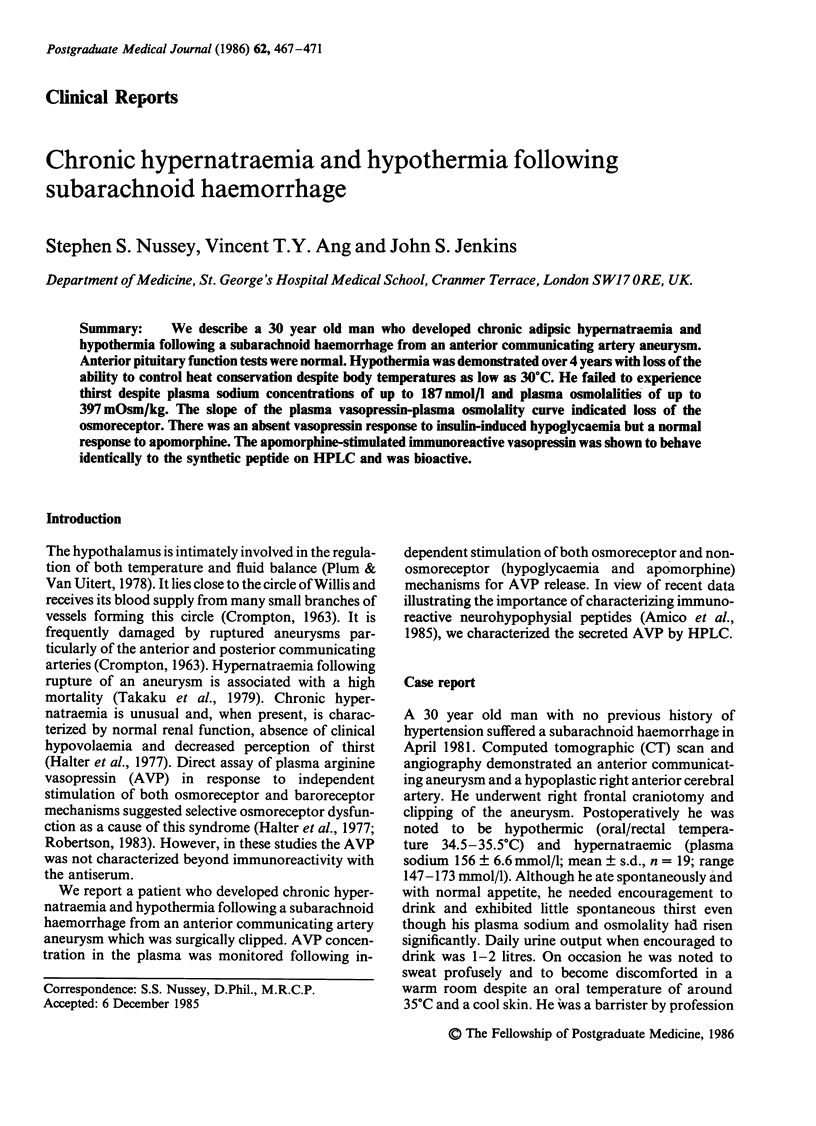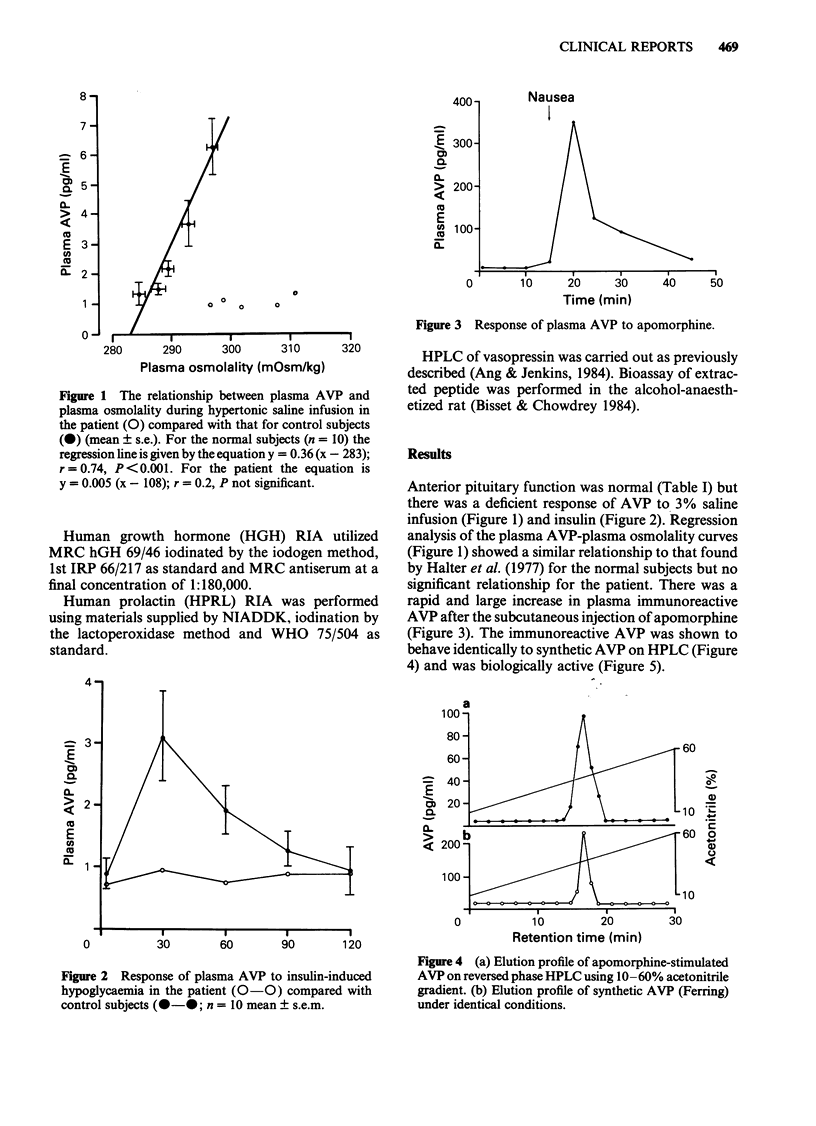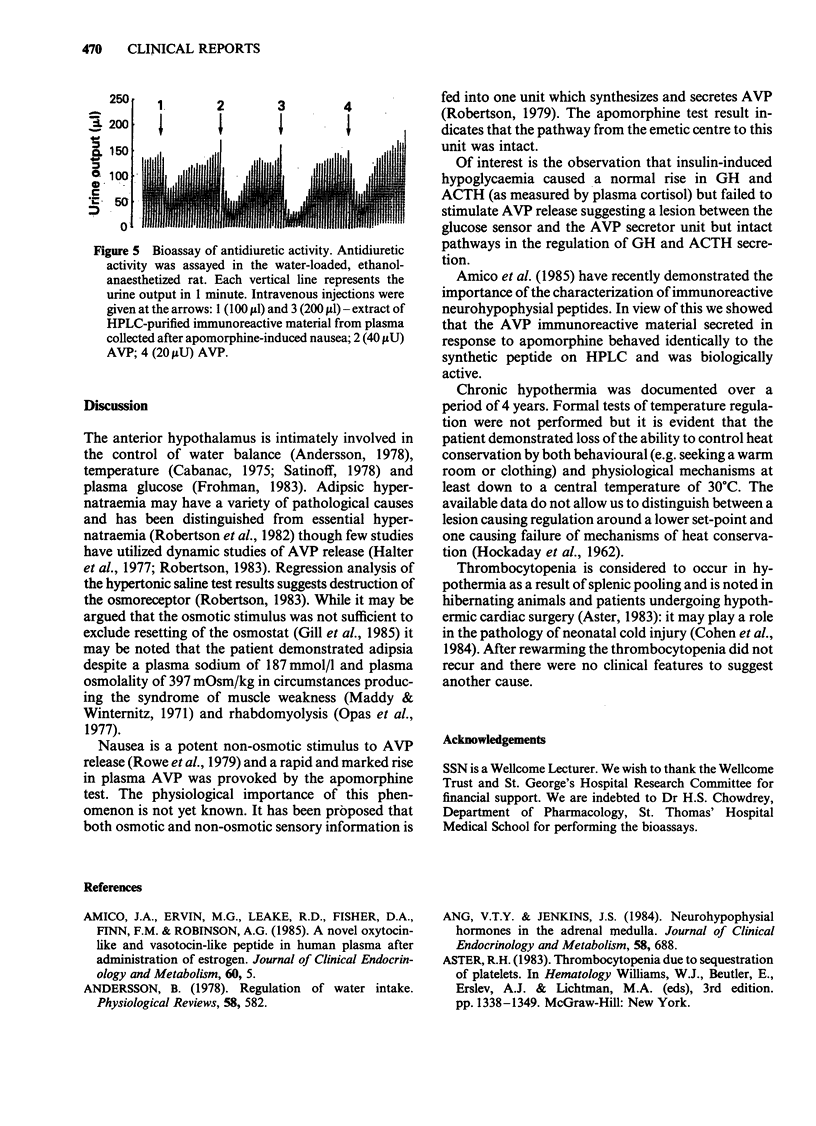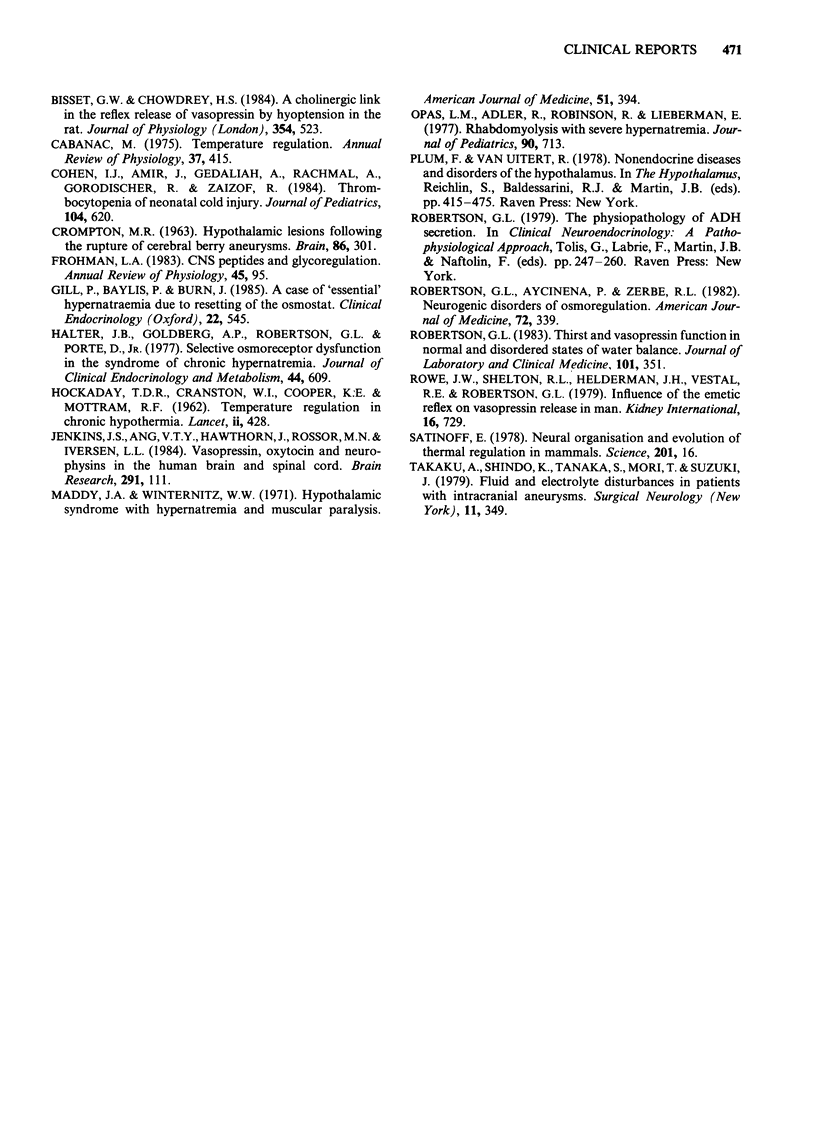Abstract
We describe a 30 year old man who developed chronic adipsic hypernatraemia and hypothermia following a subarachnoid haemorrhage from an anterior communicating artery aneurysm. Anterior pituitary function tests were normal. Hypothermia was demonstrated over 4 years with loss of the ability to control heat conservation despite body temperatures as low as 30 degrees C. He failed to experience thirst despite plasma sodium concentrations of up to 187 nmol/l and plasma osmolalities of up to 397 mOsm/kg. The slope of the plasma vasopressin-plasma osmolality curve indicated loss of the osmoreceptor. There was an absent vasopressin response to insulin-induced hypoglycaemia but a normal response to apomorphine. The apomorphine-stimulated immunoreactive vasopressin was shown to behave identically to the synthetic peptide on HPLC and was bioactive.
Full text
PDF




Selected References
These references are in PubMed. This may not be the complete list of references from this article.
- Amico J. A., Ervin M. G., Leake R. D., Fisher D. A., Finn F. M., Robinson A. G. A novel oxytocin-like and vasotocin-like peptide in human plasma after administration of estrogen. J Clin Endocrinol Metab. 1985 Jan;60(1):5–12. doi: 10.1210/jcem-60-1-5. [DOI] [PubMed] [Google Scholar]
- Andersson B. Regulation of water intake. Physiol Rev. 1978 Jul;58(3):582–582. doi: 10.1152/physrev.1978.58.3.582. [DOI] [PubMed] [Google Scholar]
- Ang V. T., Jenkins J. S. Neurohypophysial hormones in the adrenal medulla. J Clin Endocrinol Metab. 1984 Apr;58(4):688–691. doi: 10.1210/jcem-58-4-688. [DOI] [PubMed] [Google Scholar]
- Bisset G. W., Chowdrey H. S. A cholinergic link in the reflex release of vasopressin by hypotension in the rat. J Physiol. 1984 Sep;354:523–545. doi: 10.1113/jphysiol.1984.sp015391. [DOI] [PMC free article] [PubMed] [Google Scholar]
- CROMPTON M. R. Hypothalamic lesions following the rupture of cerebral berry aneurysms. Brain. 1963 Jun;86:301–314. doi: 10.1093/brain/86.2.301. [DOI] [PubMed] [Google Scholar]
- Cabanac M. Temperature regulation. Annu Rev Physiol. 1975;37:415–439. doi: 10.1146/annurev.ph.37.030175.002215. [DOI] [PubMed] [Google Scholar]
- Cohen I. J., Amir J., Gedaliah A., Rachmal A., Gorodischer R., Zaizov R. Thrombocytopenia of neonatal cold injury. J Pediatr. 1984 Apr;104(4):620–622. doi: 10.1016/s0022-3476(84)80565-x. [DOI] [PubMed] [Google Scholar]
- Frohman L. A. CNS peptides and glucoregulation. Annu Rev Physiol. 1983;45:95–107. doi: 10.1146/annurev.ph.45.030183.000523. [DOI] [PubMed] [Google Scholar]
- Gill G., Baylis P., Burn J. A case of 'essential' hypernatraemia due to resetting of the osmostat. Clin Endocrinol (Oxf) 1985 Apr;22(4):545–551. doi: 10.1111/j.1365-2265.1985.tb00155.x. [DOI] [PubMed] [Google Scholar]
- HOCKADAY T. D., CRANSTON W. I., COOP ER K. E., MOTTRAM R. F. Temperature regulation in chronic hypothermia. Lancet. 1962 Sep 1;2(7253):428–432. doi: 10.1016/s0140-6736(62)90283-0. [DOI] [PubMed] [Google Scholar]
- Halter J. B., Goldberg A. P., Robertson G. L., Porte D., Jr Selective osmoreceptor dysfunction in the syndrome of chronic hypernatremia. J Clin Endocrinol Metab. 1977 Apr;44(4):609–616. doi: 10.1210/jcem-44-4-609. [DOI] [PubMed] [Google Scholar]
- Jenkins J. S., Ang V. T., Hawthorn J., Rossor M. N., Iversen L. L. Vasopressin, oxytocin and neurophysins in the human brain and spinal cord. Brain Res. 1984 Jan 16;291(1):111–117. doi: 10.1016/0006-8993(84)90656-5. [DOI] [PubMed] [Google Scholar]
- Maddy J. A., Winternitz W. W. Hypothalamic syndrome with hypernatremia and muscular paralysis. Am J Med. 1971 Sep;51(3):394–402. doi: 10.1016/0002-9343(71)90275-0. [DOI] [PubMed] [Google Scholar]
- Opas L. M., Adler R., Robinson R., Lieberman E. Rhabdomyolysis with severe hypernatremia. J Pediatr. 1977 May;90(5):713–716. doi: 10.1016/s0022-3476(77)81233-x. [DOI] [PubMed] [Google Scholar]
- Robertson G. L., Aycinena P., Zerbe R. L. Neurogenic disorders of osmoregulation. Am J Med. 1982 Feb;72(2):339–353. doi: 10.1016/0002-9343(82)90825-7. [DOI] [PubMed] [Google Scholar]
- Robertson G. L. Thirst and vasopressin function in normal and disordered states of water balance. J Lab Clin Med. 1983 Mar;101(3):351–371. [PubMed] [Google Scholar]
- Rowe J. W., Shelton R. L., Helderman J. H., Vestal R. E., Robertson G. L. Influence of the emetic reflex on vasopressin release in man. Kidney Int. 1979 Dec;16(6):729–735. doi: 10.1038/ki.1979.189. [DOI] [PubMed] [Google Scholar]
- Satinoff E. Neural organization and evolution of thermal regulation in mammals. Science. 1978 Jul 7;201(4350):16–22. doi: 10.1126/science.351802. [DOI] [PubMed] [Google Scholar]
- Takaku A., Shindo K., Tanaka S., Mori T., Suzuki J. Fluid and electrolyte disturbances in patients with intracranial aneurysms. Surg Neurol. 1979 May;11(5):349–356. [PubMed] [Google Scholar]


